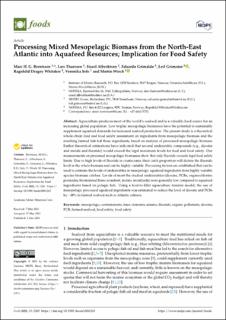| dc.contributor.author | Berntssen, Marc H.G. | |
| dc.contributor.author | Thoresen, Lars | |
| dc.contributor.author | Albrektsen, Sissel | |
| dc.contributor.author | Grimaldo, Vela Eduardo | |
| dc.contributor.author | Grimsmo, Leif | |
| dc.contributor.author | Dragøy, Ragnhild | |
| dc.contributor.author | Sele, Veronika | |
| dc.contributor.author | Wiech, Martin | |
| dc.date.accessioned | 2022-01-25T08:11:05Z | |
| dc.date.available | 2022-01-25T08:11:05Z | |
| dc.date.created | 2021-06-03T09:38:20Z | |
| dc.date.issued | 2021 | |
| dc.identifier.issn | 2304-8158 | |
| dc.identifier.uri | https://hdl.handle.net/11250/2839075 | |
| dc.description.abstract | Aquaculture produces most of the world’s seafood and is a valuable food source for an increasing global population. Low trophic mesopelagic biomasses have the potential to sustainably supplement aquafeed demands for increased seafood production. The present study is a theoretical whole-chain feed and food safety assessment on ingredients from mesopelagic biomass and the resulting farmed fish fed these ingredients, based on analysis of processed mesopelagic biomass. Earlier theoretical estimations have indicated that several undesirable compounds (e.g., dioxins and metals and fluoride) would exceed the legal maximum levels for feed and food safety. Our measurements on processed mesopelagic biomasses show that only fluoride exceeds legal feed safety limits. Due to high levels of fluoride in crustaceans, their catch proportion will dictate the fluoride level in the whole biomass and can be highly variable. Processing factors are established that can be used to estimate the levels of undesirables in mesopelagic aquafeed ingredients from highly variable species biomass catches. Levels of most the studied undesirables (dioxins, PCBs, organochlorine pesticides, brominated flame retardant, metals, metalloids) were generally low compared to aquafeed ingredients based on pelagic fish. Using a feed-to-fillet aquaculture transfer model, the use of mesopelagic processed aquafeed ingredients was estimated to reduce the level of dioxins and PCBs by ~30% in farmed seafood such as Atlantic salmon. | en_US |
| dc.language.iso | eng | en_US |
| dc.publisher | MDPI | en_US |
| dc.rights | Navngivelse 4.0 Internasjonal | * |
| dc.rights.uri | http://creativecommons.org/licenses/by/4.0/deed.no | * |
| dc.subject | food safety | en_US |
| dc.subject | feed safety; | en_US |
| dc.subject | farmed seafood; | en_US |
| dc.subject | PCB; | en_US |
| dc.subject | dioxins; | en_US |
| dc.subject | organic pollutants; | en_US |
| dc.subject | fluoride; | en_US |
| dc.subject | arsenic; | en_US |
| dc.subject | trace elements; | en_US |
| dc.subject | contaminants; | en_US |
| dc.subject | mesopelagic; | en_US |
| dc.title | Processing Mixed Mesopelagic Biomass from the North-East Atlantic into Aquafeed Resources; Implication for Food Safety | en_US |
| dc.type | Peer reviewed | en_US |
| dc.type | Journal article | en_US |
| dc.description.version | publishedVersion | en_US |
| dc.rights.holder | Copyright: © 2021 by the authors. Licensee MDPI, Basel, Switzerland. This article is an open access article distributed under the terms and conditions of the Creative Commons Attribution (CC BY) license (https:// creativecommons.org/licenses/by/ 4.0/ | en_US |
| dc.source.pagenumber | 19 | en_US |
| dc.source.volume | 10 | en_US |
| dc.source.journal | Foods | en_US |
| dc.source.issue | 6 | en_US |
| dc.identifier.doi | 10.3390/foods10061265 | |
| dc.identifier.cristin | 1913462 | |
| dc.source.articlenumber | 1265 | en_US |
| cristin.ispublished | true | |
| cristin.fulltext | original | |
| cristin.qualitycode | 1 | |

